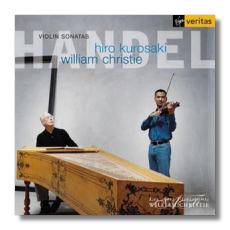
The Internet's Premier Classical Music Source
Related Links
- Handel Reviews
- Latest Reviews
- More Reviews
-
By Composer
-
Collections
DVD & Blu-ray
Books
Concert Reviews
Articles/Interviews
Software
Audio
Search Amazon
Recommended Links
Site News
 CD Review
CD Review
George Frideric Handel

Violin Sonatas
- Violin Sonata in A Major, HWV 372
- Violin Sonata in G minor, HWV 364a
- Violin Sonata in D Major, HWV 371
- Violin Sonata in A Major, HWV 361
- Violin Sonata in D minor, HWV 359a
- Violin Sonata in G Major, HWV 358
- Violin Sonata in F Major, HWV 370
Hiro Kurosaki, violin
William Christie, harpsichord and organ
Virgin Veritas 45554 DDD 59:31
Documentation in the 1700s not being what it is today, matching composers and compositions can be a matter of guesswork. There's no way of knowing whether or not George Frideric Handel really wrote all seven of these sonatas. Even if he did, it is quite possible that some of them were written for different instruments than the ones used here. It can be a humbling lesson for musicologists to learn that a great piece of music is still great regardless of who wrote it, and for what combination of instruments.
At any rate, the sonatas included here probably come from Handel's youth, old age, and everything in between. The D-major sonata (HWV 371) is thought to be among the composer's last works. On the other hand, the G-major sonata (HWV 358) is likely to have been written when he was in his twenties. Nevertheless, these seven sonatas are of a consistently high quality, and ingratiating to both the ear and the intellect.
Customarily, works such as these would be performed by a soloist with continuo, which – at a minimum – usually consists of a keyboard instrument (harpsichord or organ, for example) and a lower stringed instrument such as the cello or the viola da gamba. Kurosaki and Christie have done without the latter, for reasons justified in the booklet note. I don't miss it. Christie provides rock-solid support for Kurosaki's violin, and the music's harmonic foundation is never in question.
Kurosaki plays a Giovanni Battista Rogeri violin, made in Brescia around 1690. In other words, it might conceivably have been used to play this music when it was new. It has a brilliant sound (but not shrill), and in its lower registers it is appealingly throaty. Although Kurosaki doesn't use a lot of vibrato, one doesn't tire of his tone. William Christie plays modern recreations of old instruments: a two-manual Hemsch-style harpsichord built by Ducornet and Danset, and a positive organ by Johan Deblieck. (The choice between harpsichord and organ is discretionary, and I appreciate the variety in timbre that results from alternating the two.) On discs, Christie appears as a conductor more frequently – for example, for Les Arts Florissants – and it is nice to be reminded of his versatile talents playing keyboard instruments.
The verdict is easy to deliver. This is relatively unfamiliar music that encompasses a wide range of emotions with grace and intelligence. There's no hint of monotony here. Kurosaki and Christie play the sonatas with vitality and discernment, and with no little personality. The flawless engineering creates a palpable feeling of performance space. No reservations: this is worth exploring.
Copyright © 2003, Raymond Tuttle


















